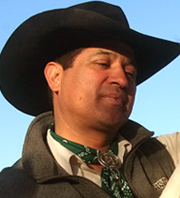Four Generations of Charro
Michael May
JANUARY 12, 2008
- Bandito Y Yo
- (Michael May)
- View the Slideshow
Web Resources
More From Michael May
Recorded mariachi music pours out of an enormous barn and rolls across the fences and dusty prairie of Jerry Diaz's ranch in New Braunfels, Texas. It's the music that Jerry uses in his show, and he wants the horses to feel it in their bones before they enter the ring. Jerry stands at the end of a long row of horse stalls in a wide sombrero and a bola tie embossed with his initials. He's carefully shaving the ears of his horse, Pajaro, in preparation for the show.
"They've got to be in great shape," he says. "They have to feel very confident about what they're going to do in the. You can see this horse's eyes, the sincereness in his eyes." Then he turns to Pajero. "Almost done with your ears, Pajaro. Pajero give me a kiss! He gave me a big kiss, good boy."
This weekend Jerry will get Pajaro to dance and do pirouettes in the show. And for the finale he does a trick called the wedding ring, where he spins a 65-foot lasso around himself and his horse at full gallop.
Jerry mounts another horse named Bandito and sits tall. It's hard to even notice the subtle directions he's giving the animal.
"I cue the horse with my right foot, and I extend my left foot to the left, and I make the horse go towards you. You can see him crossing his front legs towards you."
Bandito pranced directly sideways, right into my microphone.
I ask what is the most difficult trick to teach.
"The 'tricks' are the easiest," Jerry says. "Putting a good handle, a good reins, good control on the horse, is the most difficult. And the most difficult on top of that is to learn what's going through his mind. We only think we've gotten into his mind. How do we know that we have?"
Jerry's great-grandfather was a rancher in Jalisco, Mexico, where he learned how to rope and ride by working on the ranch. Jerry grew up in the United States competing in the ring, as a rodeo charro, even riding bulls. But he's had a few opportunities to rustle cattle on the open range, and he says that's where the true charro is made.
"In the arena, you have a second chance. Out in the open, you don't. You may never see that cow, steer or bull again. When you go out on the open range -- and there are bulls that possibly have never seen a human being -- and you show up on horseback, and you separate one out there, you and it alone. That's a whole different ballgame. And no one to see you."
On the other side of Jerry's property are two ranch-style homes -- one for his family, and the other for his parents. His father, Don Pepe Diaz, was the man who took the charro tradition from the ranch to the stage. He left Jalisco to train horses for the president of Mexico before moving to Texas in the 1940s. He got picked up by Ringling Brothers and was a stunt double on the 1950s-era TV series "The Cisco Kid."
Inside his house, 89-year-old Don Pepe sits tall and proud, still dapper with a bandanna tied around his neck. He can no longer walk, but he still rides. Jerry reveres his dad, and his father is hoping future generations keep up the family tradition.
It would be a wonderful thing that would make him happier than anything, he says in Spanish. And then he emphasizes that everything he's passed on, he learned from his own father in Mexico.
Outside, Jerry's wife Staci and his young son Nicolas are getting ready for the trip. Nicolas is already part of the family act.
"I spin my rope. And then I throw it. And then I sell it," Nicolas proclaims.
"And what does the crowd do?" I ask.
"They go 'walken wok! Walken wok!'"
The crowd also goes "walken wok" -- whatever that means -- for his mom. Staci Diaz comes from a riding family too. Her specialty is Roman riding, where you straddle two galloping horses while standing up. The sight is part of everyday life for Nicolas.
"We came out of the hospital, he was only five days old when my husband takes him for his first ride in his arms," Staci recalls. "He's four years old [now], and we still never just turn him loose and just ride."
But Nicolas does get to stand up on a horse.
"He stands up on a horse and spins his rope, but his daddy's right there, and I'm right there to catch him if he goes one way or another," she laughs.
Staci and Nicolas go back to loading the trailer. Inside, next to bridles decorated with silver medallions, is an ancient hand-stitched saddle with a horn inlayed with mother of pearl. Jerry's great-great uncle back in Mexico made the saddle. Now Nicolas will ride it into the ring in Denver.







Comments
Comment | Refresh
Post a Comment: Please be civil, brief and relevant.
Email addresses are never displayed, but they are required to confirm your comments. All comments are moderated. Weekend America reserves the right to edit any comments on this site and to read them on the air if they are extra-interesting. Please read the Comment Guidelines before posting.
You must be 13 or over to submit information to American Public Media. The information entered into this form will not be used to send unsolicited email and will not be sold to a third party. For more information see Terms and Conditions and Privacy Policy.